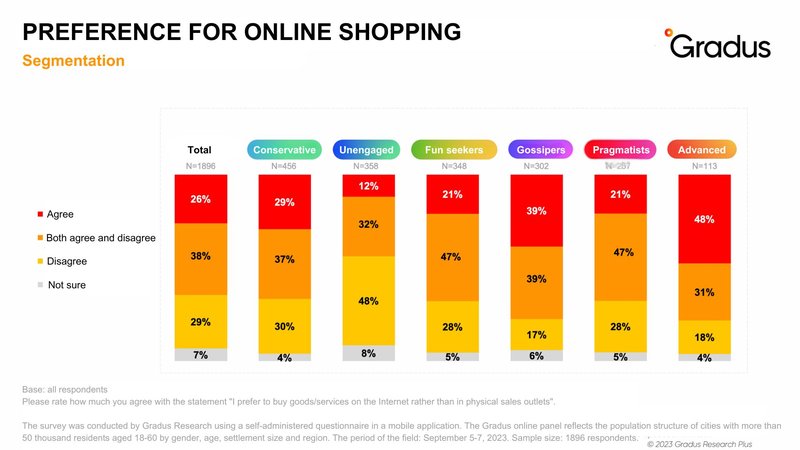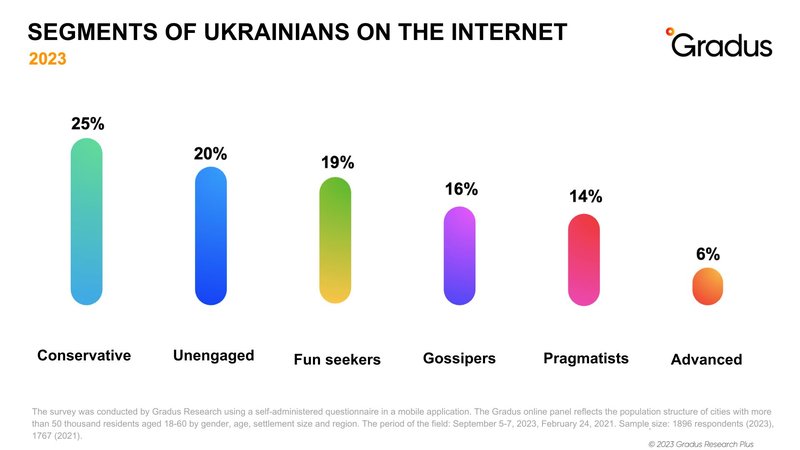How actively do Ukrainians spend money online and on what exactly?

How do Ukrainians buy online and what other financial transactions do they conduct online? The answer to this question was sought by analysts of the research company Gradus Research, who conducted a relevant marketing survey among Ukrainian digital users.
"Today, Ukrainian society is as digitalized as possible, and this concept of constant "online" is manifested in the regular search for up-to-date information, "checking in" with relatives in messengers, and buying goods online. At the beginning of the pandemic, offline and online shopping competed with each other, and the former was more common, as people were used to going to stores and choosing goods physically. With the outbreak of full-scale war, the boundaries between offline and online shopping have become blurred, as almost the same number of respondents prefer each of these methods of purchasing goods. This once again demonstrates the rapid adaptation of Ukrainians to the conditions in which we find ourselves," says Evgeniya Blyznyuk, sociologist, founder&CEO of Gradus Research.
More than a quarter of Ukrainians prefer online shopping, and another 38% buy both online and offline
Digital shopping has already become commonplace for Ukrainian consumers. 26% of respondents prefer to shop online. Another 38% buy both online and offline.

At the same time, the overwhelming majority of respondents (87%) generally believe that online shopping is easy.
However, not all Internet users in Ukraine use the Internet with the same intensity and set of actions, including for shopping. The study divided all users into 6 segments based on their online behavior patterns.

Active and highly engaged online consumers make up just over a third (36%)
This includes a segment that is conventionally called Advanced. These are users who intensively consume and create content, follow brand communications, and compare their values, products, and services with each other. They are also active in daily purchases of goods and services online. More than half of them (54%) shop online at least once a day. However, this is also the smallest segment, with only 6% of respondents.
Another active segment is Gossipers (16%). For them, the Internet is primarily a social circle and an option for communication. Online, they buy goods and services almost every day (13%), pay bills (17%), and use online banking (62%).
We also include the Pragmatists segment, which accounts for 14% of active users. They use the Internet to get news and thematic information and are active users of educational services and media. They make financial transactions online no more than a few times a week.
The other two-thirds of respondents (64%) are less active digital shoppers
Entertainment seekers, who account for 19% and mostly consume online games and entertainment content on social media, are rather inert when it comes to online financial transactions. They compare prices for goods and services several times a month or less (53%) and use online banking services (36%).
Moderates (25% of the total sample), who use the Internet to search for information and read news, do not actively conduct financial transactions online, limiting themselves to performing most transactions once or several times a month. The only exceptions are comparing prices for goods and services (38%) and using banking services (38%) — these operations are more likely to be performed by Moderates several times a week.
The Uninvolved (20% of respondents), who are rarely "online" and for whom the Internet is primarily a source of communication, perform almost or no financial transactions on the Internet. Among the Uninvolved, the largest share of those who prefer to shop offline (48%). They say they have difficulty making purchases online (13%).
The survey was conducted by Gradus Research using a self-administered questionnaire in a mobile application. The Gradus online panel displays the population structure of cities with more than 50 thousand residents aged 18-60 by gender, age, settlement size, and region. Field periods: September 5-7, 2023, sample size — 1896 respondents.
Successful
Other reports
-
 Довіра до підприємців в Україні: кого підтримує суспільство під час війниJuly 2025Спеціальне опитування для Forbes Ukraine щодо ставлення бізнесменів
Довіра до підприємців в Україні: кого підтримує суспільство під час війниJuly 2025Спеціальне опитування для Forbes Ukraine щодо ставлення бізнесменів -
 Life Quality Barometer 2025July 2025Joint study with EBA on the impact of full-scale war
Life Quality Barometer 2025July 2025Joint study with EBA on the impact of full-scale war -
 Wartime survey of Ukrainian society / twelfth waveJune 2025Ukrainians are exhausted but not discouraged: results of the 12th wave of the Gradus Research survey
Wartime survey of Ukrainian society / twelfth waveJune 2025Ukrainians are exhausted but not discouraged: results of the 12th wave of the Gradus Research survey -
 Expectations from employers in a situation of total burnoutMay 2025Special HR survey of expectations from employers and the level of burnout among Ukrainians
Expectations from employers in a situation of total burnoutMay 2025Special HR survey of expectations from employers and the level of burnout among Ukrainians





